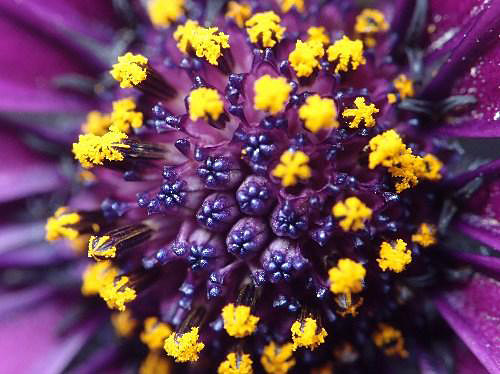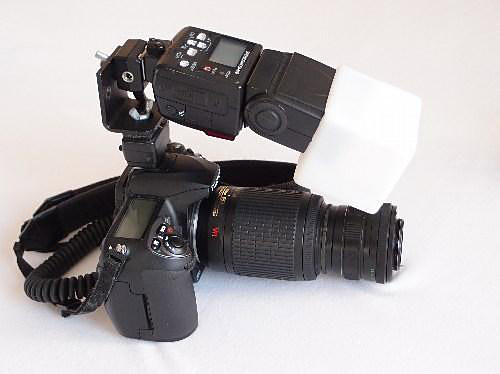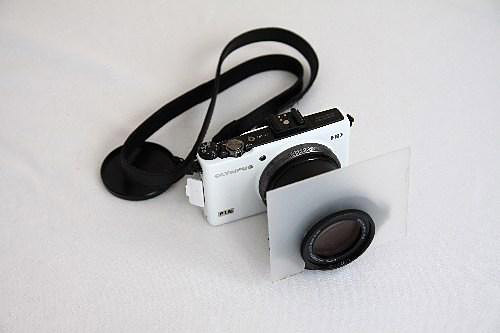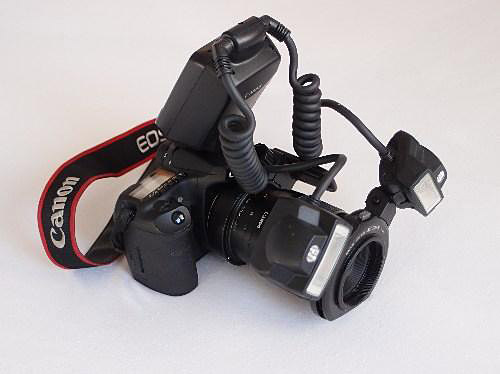Using different macro accessories along with standard lenses
Specific macro accessories include:
a. extension rings,
b. teleconverters,
c. macro converters,
d. bellows,
e. lens adapters and lens reversing rings,
f. focusing rails,
g. macro flashes,
h. other.
Ad.a) Extension rings are simply tubes of different length that can be attached to one another and to a camera and lenses. They are used for the purpose of increasing the distance between the camera and the lens and thus increasing the magnification. The result is that the lens cannot focus to infinity. Thanks to electrical contacts more. Advanced extension rings allow the transfer of all the automatic functions from the camera to the lens. These rings enable us to change a universal lens into a macro lens. Using the extension rings we have to be aware of the loss of light that reaches the sensor. The longer the rings, the greater the loss of light. Both the magnification and the loss of light depend on the relation between the lens focal length and the length of the extension rings. The greater the loss of light, the longer exposure times are required, of course.
Ad. b) Teleconverters are nothing more than extension rings with such a group of lenses that allow you to magnify the resulting image. Thanks to this they are much shorter than the extension rings allowing the same magnification. Similarly they are mounted between the camera and a photographic lens. Teleconverters are typically made in 2x and 1.4x models. Their quality is constantly being improved and brand-name teleconverters are not worse than the best lenses. Thus using a teleconverter has practically no influence on the quality of the final image. Canon and Nikon currently offer the third generation of teleconverters, for example. A teleconverter used together with a macro lens allows you to get even 2x magnification. They can be used not only in macro photography but also to increase the focal length of any other lens. However, there’s no such thing as a free lunch. Teleconverters also decrease the amount of light that reaches a sensor of a film. If we mount 2x teleconverter on 100 mm f/2,8 lens we will get 200mm f/5,6 lens. Nothing stands in a way of attaching extension rings to this set in order to achieve even greater magnification. We mount them between a camera and a teleconverter which of course causes further loss of light.
Ad. c) Macro converters that are also called close-up lens are simply lens or groups of lenses mounted to the front of a camera lens. They can be screwed or snapped on to the front filter-ring of the camera lens. Their function is to shorten the lens focal length allowing any primary lens to focus more closely and produce greater magnification. They are usually used in compact cameras as they do not offer the possibility of higher magnification. Raynox offers a great variety of macro converters.
They have snap-on universal mount suitable for 52 mm to 67 mm filter diameters so they can be attached really fast. Depending on the type they offer different degrees of magnification. They are made of high-performance optical glass and using them does not lead to a degradation of image quality. Most reputable producers of DSLR cameras also offer excellent close-up lens made of achromatic glass that reduce lens aberration and even improve their sharpness. Compact cameras usually require special set-up ring to attach filters and converters. Set-up rings screw into the special thread located on the camera body around the camera lens.
Below I present you a few photos made with OlympusXZ-1 compact camera with Raynox Digital Camera Macroscopic Lens 4x macro converter.



These converters may successfully be used together with macro lenses and DSLR cameras in order to produce magnification greater than 1x. Using close-up lenses with zoom lenses may be also interesting. The result of such combination will be macro zoom lenses.
Ad.d) Bellows are also a tube but square diameter one and thanks to their concertinaed construction they are continuously adjustable in length. Although, most of them have not got contacts that allow an electronic automatic camera to control the lens, there are also some that are capable of it. Novoflex produces modern bellows that transfer all the automatic functions between acamera and a lens in which f-number and light measurement are transfered by steps.
BALNIK AF (for Nikon) and BALCAN AF (for Canon) are universal bellows with 1/4” tripod threads.
BALPRO is the simplest universal bellows. With the use of the special adapters it can be attached to almost any system and lens. It is compatible with most of the medium format and 35mm cameras and also with the special lenses in all formats up to 6x7.
BALPRO-TS are universal bellows with Tilt Shift function (both at the front and at the back of bellows). It can be even used with 6x6 system. Is serves well for the perspective and depth of field correction. Using bellows has the same advantages and disadvantages that come with using extension rings. Their advantage over the rings is that they allow smooth change of magnification, however, they are more fragile and less handy.
As long as in studio macro photography I consider bellows to be quite useful, I cannot imagine using them while being in the field. In my opinion they are too cumbersome.
Ad. e) Lens reversing rings make it possible to attach the lens to the camera in reverse. It results in converting an ordinary short telephoto lens into a macro lens.
Such adapter is a ring that at one end has got a mount compatible with a certain system and at the other end a thread of a specific diameter which matches the filter thread on the front of a lens. We can use any system lens because we are not limited by the mount type. After mounting it we only have to block the aperture lever in the open position. The drawback of this combination is the lack of all the automatic functions. Reportedly, there are some adapters that can be connected to the lens contacts using a cable. An interesting alternative to this solution is using the macro coupler to mount a lens in reverse, in front of a normally mounted lens. This special ring screws into the front filter threads of both lenses. I came upon some interesting results while mounting in reverse Helios lens for Zenit camera of Soviet production to an inexpensive AF-S Nikon DX 55-200 f4-5,6 G IF-ED VR telephoto lens. What I got was stabilized macro zoom with 3x magnification and quite decent optical parameters. The only drawback was the shallow depth of field. I order to lighten the object I used horizontally mounted SB600 flash by means of a bevel and TTL-SC28 sync cable. I made the light diffuser myself. Here are a couple of photos taken with this set.


The fragment of 20 cent euro coin.

The hallmark on the gold wedding ring.
Even better results can be attained screwing together Canon100mm macro L IS and Nikon Af-S 50mm 1:1,4G lenses.
An example shoot with this set below:

The fragment of an orchid flower, very similar to an alien.
As a matter of fact, all the macro photographers are inventors trying out the strangest combinations and sets. Just as the alchemists looked for the philosophers' stone, we search for an incredible equipment. Certain combinations, whose photos and descriptions, you can find on the Internet can be quite surprising. Look at my handmade light diffuser for a flash, for instance. I made it using a lamp with glowing diodes inside. It has got plenty of advantages. Firstly, it is big enough to softly blur the shade of the photographed object and make it look really natural. I think that this solution is better than a dual flash, not to mention a ring flash but I will write about it later. Its second advantage is that you can light it and take photos at night without any problems.
Ad. f) A focusing rail is a device that is used to focus in and compose a shot precisely for greater magnifications. It consists of two perpendicular rails with serrated slats. Thanks to gears one of them can be moved forwards and backwards and the other to the sides. We attach a camera to a focusing rail and mount this set on a tripod.

Personally, I am not a fan of using this device. In my opinion it causes considerable instability and the heavy set of a camera, a lens and a flash is susceptible to vibrations. There are, however, photographers who cannot imagine their work without it. Well for me even a tripod is unnecessary and I use it only in exceptional cases (e.g. when taking shots of moving drops of water).
Ad. g) Flashes are indispensible tools in macro photography. As I mentioned before they give you the comfort of using smaller apertures, allowing you to freeze the movement, increase colour saturation very often, and bring out more details. Dynamic range is increased, especially in worse lighting conditions. The use of flashes has also got its drawbacks. In the lack of light situation when the background is relatively far from the subject, in the photo it comes out very dark or even black. It can be sometimes avoided using additional flashes but it is not always possible. When taking shots of small and closely situated object, the problems with automatic exposure metering can also occur. A lot depends on the experience of the photographer and the use of the suitable light metering; either spot metering, matrix metering or centre-weighted metering. The need for the exposure or flash power correction frequently occurs. It is also helpful to use different kinds of light diffusers that “soften” the light and disperse it allowing to get rid of the excessive contrasts and sharp, strongly outlined shadows.
Another disadvantage of using flashes is that the light they produce reflects in all the glossy and even semi-matte surfaces. It often produces not interesting or unwanted effects.

The light of the dual flash is reflected in the eyes of a dragonfly.
Some bizarre patterns similar to hieroglyphs are formed on the surface of a drop of water.

A lot of producers offer flashes specially designed for macro photography. It is not always necessary to buy them. As it was mentioned before, you can use simple external flash if mounted appropriately. If there isn’t the need for the high light intensity you can also use built-in flash with a special light diffuser that allows you to distribute the light evenly.

A piece of transparent plastic plate attached to a close-up lens and mounted to Olympus XZ1 camera forms a nice macro set. The light of the built-in flash dispers on the plastic plate and illuminates the object evenly, almost shadelessly. On the Internet you will find a lot of clever constructions e.g. the diffuser in a shape of a quadrangular pyramid made of some transparent material. Its top is cut and put on the raised build-in flash, the base is directed to the front and situated over the lens.
Additionally, its sides are covered inside with some fluorescent material. The special macro flashes are produced as dual flashes or ring flashes. In both types flash tubes are placed right next to a lens.

Twin Lite 24EX dual flash for Canon
Two separate flash heads can be swivelled around the lens, moved forward and backward and even one of them can be switched off independently. Its guide number is 24 which is enough in most cases. For Canon 100mm Macro L IS lens you will need additional ring - Macrolite adapter 67. Ring flashes are similar in construction, the only difference is that the flash units are built into a homogenous ring around a lens. Owing to it the photos you get are almost shadowless. The question remains if it is recommended in macro photography. For me such photographs look flat, unnatural and they lack details. In reality even on a cloudy day some shadows occur. Apart from that some round images are reflected in glossy surfaces such as e.g. insects’ eyes which looks completely unnatural.
Contemporary flashes, both external and built-in ones are fitted with automatic light metering system i-TTL. It works this way: flash emits preflashes that are reflected and end up in the light meter which regulates the flash power in such a way to obtain a correct exposure. All cameras have minimum shutter speed at which they synchronise with a flash. In SLR cameras it is most often 1/250s. This is usually enough to freeze the movement, however, in case of insects moving their wings very quickly, it’s sometimes impossible. In many advanced cameras there is a high-speed flash sync mode called Auto FP. This mode allows you to synchronize the flash with times up to 1/8000s. However, in such short time a flash may not manage to send enough amount of light for the proper exposition.
Working with a flash we can choose two options from the camera menu; the full flash and the fill flash. The first one assumes that the flash is the main source of light and it should always be used when we want to freeze the movement or when the great amount of light is needed e.g. small aperture, high magnification. The full flash has got disadvantages namely it causes dark background and heavy shadows. Here the
alternative can be a fill flash which, as the name suggests, compensates the shortages of the ambient light, “filling” the scene with light that is missing. It is advisable to use a fill flash when taking shots of still objects as it helps you to bring out more colours and details in the background.
In macro photography it is worth using additional flashes that allow suitable lighting of both an object and the background. Many cameras and flashes enable wireless control of other compatible flashes by remote flash triggering.
Ad. h) There are plenty of other useful accessories for macro photography but it is not possible to describe them all here. Let’s take an optical angle viewfinder for example. It enables comfortable shooting above the ground with no need of lying down. Additionally, it is capable of magnifying an image in a viewfinder up to 2,5x.

Canon Angle Finder C

Olympus Macro Arm Light that allows you to illuminate the image you want to capture.
There is also the issue of which camera type is best for macro photography. Views on this matter are completely divided. A lot of good macro photographers use compact cameras, especially because of their large DOF. While it can be justified in case of still objects, with fast moving objects it seems to be a misunderstanding on account of the long shutter lag. A fast insect will fly away far before a camera manages to take a picture after a shutter release button was pressed. The smaller image sensor in compact cameras has its cons too. The resolution is lower, the image noise is stronger, especially with high ISO. Moreover, the quality of their lenses is much worse than that of the macro lenses for DSLR cameras. On the other hand, professional full-frame cameras have an excellent quality and offer great possibilities, however, owing to the size of a sensor the DOF is smaller. Some kind of compromise can be APS-C cameras. More advanced models are not much worse than full-frame cameras as far as the quality of image is concerned and framing a particular subject you can obtain larger DOF.
I use two APS-C cameras - Canon 50D and Fuji Fine Pix 5 PRO. I do not need to praise Canon as it is classified high in all the rankings for years. Fuji is not that well-known but it is a sensational camera as well. It has got an excellent sensor with incredible HDR. It is hard to take overexposed photos with it and it shows detail where the other cameras show dark shadow. It is designed for Nikon system.
In my view, any owner of any decent camera has a chance to display one's skills in close-up photography. You only have to fall in love with it as I did, and look for something that lures you the most.


